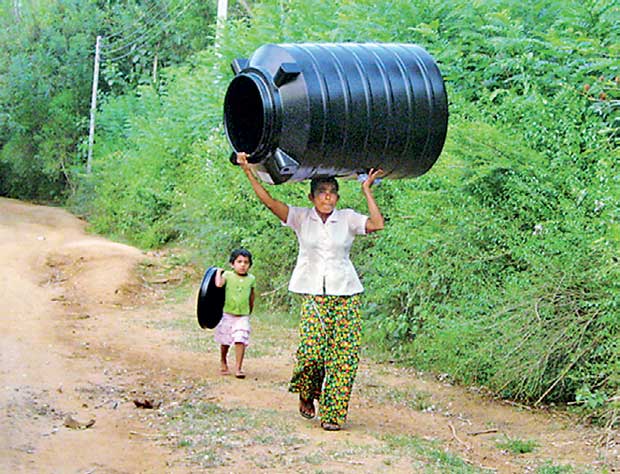20 Oct 2016 - {{hitsCtrl.values.hits}}

By Amantha Perera
Thomson Reuters Foundation: In this village in Southern Sri Lanka’s Hambantota district, water sales are big business.
Beset by a prolonged dry spell and day-time temperatures reaching above 36 degrees Celsius (97 degrees Farenheit), the village has seen all of its wells run dry.
Water arrives once every three days in the form of a free government tanker, but it’s not always enough to last. Buying a tanker of water privately costs Rs.5,000 (US$34), more than most people can pay.
Instead the village’s farmers and traders buy their water in one-liter bottles from small-scale vendors who charge Rs. 4-10 liter (less than one U.S. cent) for drinking water brought from about 30 kilometres away.
“We buy drinking water, and try to use other sources for cooking and washing,” said Sarath Mahanama, one villager. Those other sources include the muddy puddle left in the bottom of a nearly empty nearby water reservoir.
Mahasenpura is not alone in its shortages. Nine districts in Sri Lanka’s Southern, Northern, North Eastern and Southeastern Uva provinces have been hit by drought. According to the national Disaster Management Center, by mid-October over 875,000 people were being provided with government tanker water in these areas.
The worst hit area, where over 160,000 people are currently dependent on water brought in from outside, is North-Central Polonnaruwa district.
“This is what we undergo every year. After the floods, there will be a drought and we are almost dying of thirst,” said Tissa Poddibanda, a villager from the Lankapura area.
Lankapura is one of the worst-affected sites in the country, with close to 30,000 persons waiting for transported water.
Drought to floods
As the weather becomes more extreme, Sri Lanka finds itself increasingly in a debilitating pattern of alternating between drought and floods - both of which can lead to shortages of clean water.
In May, large areas of the country were flooded which caused damages of more than $3 billion, according to the Finance Ministry. Three months later drought hit.
While weather experts and policy makers increasingly see the worrisome pattern, potentially effective national interventions are not yet in place, experts say.
Today, in some drought-hit areas of Sri Lanka, for instance, water remains in storage dams but officials are reluctant to release it, fearing there will not be enough irrigation water for farmers to plant in the next growing season that starts in November.
The Parakarama Samudraya, the largest reservoir in northern Polonnaruwa district, is currently at about 50 percent of capacity, officials say. But government irrigation officials say they don’t want to release the waters - and the next wave of heavy rains is expected only in mid-November, with the onset of the Northeast monsoon season.
As competition for water grows, better cooperation is needed between the various government agencies handling water to balance the needs of farmers, hydropower suppliers and household users, said S.L. Weerasinghe, director-general of the national irrigation department.
“Right now there is very little coordination between various entities handling water, from power to agriculture. We need a much more cohesive water management policy to safely release water stored for agriculture,” Weerasinghe said.
Not prepared
Lack of public awareness about the extent of the country’s water problems and how they might be better managed - is another problem, water management experts say.
“We are not prepared to meet these impacts” of climate change, said Kusum Athukorala, who heads the Sri Lanka Water Partnership, a non-profit national organisation working on water management.
She said that since Sri Lanka’s devastating 2004 tsunami the island has upgraded and strengthened its disaster response capacity but hardly any work had been done on preparing for disasters and building public awareness about them.
Villagers such as Poddibanda, who are the mercy of changing rainfall patterns, have had little help in learning to manage water better, though it is crucial to their economic well being, experts say.
Poddibanda, like most farmers in water-short Lankapura, waits until he believes rains are close to arriving to prepare his paddy rice plot for cultivation - and he expects the government to provide free irrigation water, irrespective of rain and reservoir levels.
He said he has not responded to government requests for farmers to break with tradition and plant when water is available, rather than at traditional times.
“I don’t know how to do that,” Poddibanda admitted.
Athukorala said a sustained public awareness campaign is needed to build community knowledge about water management, and a national water management policy is needed to coordinate water planning among sectors such as power, agriculture, weather, irrigation and disaster management.
In addition, “we have to take care of each spring, each river, each well. You do preventive medicine and spend less on curative medicine,” she urged.
25 Nov 2024 3 hours ago
25 Nov 2024 4 hours ago
25 Nov 2024 4 hours ago
25 Nov 2024 6 hours ago
25 Nov 2024 6 hours ago